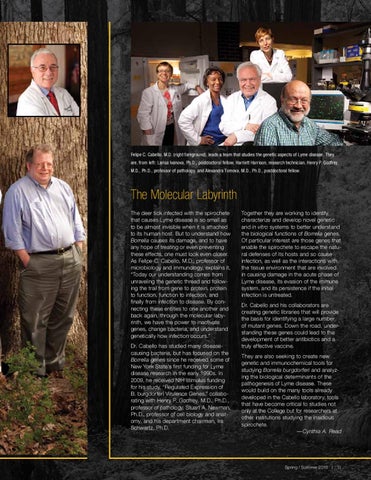Felipe C. Cabello, M.D. (right foreground), leads a team that studies the genetic aspects of Lyme disease. They are, from left: Larisa Ivanova, Ph.D., postdoctoral fellow, Harriett Harrison, research technician, Henry P. Godfrey, M.D., Ph.D., professor of pathology, and Alexandra Tomova, M.D., Ph.D., postdoctoral fellow.
The Molecular Labyrinth The deer tick infected with the spirochete that causes Lyme disease is so small as to be almost invisible when it is attached to its human host. But to understand how Borrelia causes its damage, and to have any hope of treating or even preventing these effects, one must look even closer. As Felipe C. Cabello, M.D., professor of microbiology and immunology, explains it, “Today our understanding comes from unraveling the genetic thread and following the trail from gene to protein, protein to function, function to infection, and finally from infection to disease. By connecting these entities to one another and back again, through the molecular labyrinth, we have the power to inactivate genes, change bacteria, and understand genetically how infection occurs.” Dr. Cabello has studied many diseasecausing bacteria, but has focused on the Borrelia genes since he received some of New York State’s first funding for Lyme disease research in the early 1990s. In 2009, he received NIH stimulus funding for his study, “Regulated Expression of B. burgdorferi Virulence Genes,” collaborating with Henry P. Godfrey, M.D., Ph.D., professor of pathology, Stuart A. Newman, Ph.D., professor of cell biology and anatomy, and his department chairman, Ira Schwartz, Ph.D.
Together they are working to identify, characterize and develop novel genetic and in vitro systems to better understand the biological functions of Borrelia genes. Of particular interest are those genes that enable the spirochete to escape the natural defenses of its hosts and so cause infection, as well as the interactions with the tissue environment that are involved in causing damage in the acute phase of Lyme disease, its evasion of the immune system, and its persistence if the initial infection is untreated. Dr. Cabello and his collaborators are creating genetic libraries that will provide the basis for identifying a large number of mutant genes. Down the road, understanding these genes could lead to the development of better antibiotics and a truly effective vaccine. They are also seeking to create new genetic and immunochemical tools for studying Borrelia burgdorferi and analyzing the biological determinants of the pathogenesis of Lyme disease. These would build on the many tools already developed in the Cabello laboratory, tools that have become critical to studies not only at the College but for researchers at other institutions studying the insidious spirochete. —Cynthia A. Read
Spring / Summer 2010 | 11
